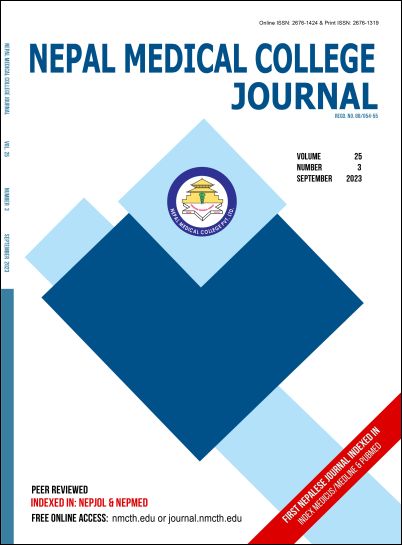Prescription audit and drug interactions of anti-diabetic drugs at Outpatient Department at a tertiary care teaching hospital in Eastern Nepal
DOI:
https://doi.org/10.3126/nmcj.v25i3.58724Keywords:
Drug interaction, Polypharmacy, Type 2 diabetes, Prescribing, audit, anti-diabetic drugs, NepalAbstract
Type 2 diabetes mellitus (T2DM) is the third major non-communicable disease in Nepal. Drug utilization studies help in reducing the patient’s expenditure, adverse drug reactions and drug-drug interactions. It would help in understanding of consumption of drugs including newer ones. Objective was to analyze the prescribing pattern and drug interactions of anti-diabetic drugs. A prospective cross-sectional study was conducted among patients having T2DM at Birat Medical College and Teaching Hospital (BMCTH), Biratnagar, Nepal from May 2019- August 2019. WHO core drug use indicators were used to analyze the obtained data. Descriptive statistics like mean, standard deviation, frequency and percentage were calculated using Microsoft Excel 2013. Out of 200 patients, 104 (52.0%) were females and 49.5% were from the age group of 41-60 years. Average number of drugs per patient was 5.74. Biguanides (40.7%) were the most common prescribed oral antidiabetic drugs followed by Sulfonylureas (23.3%). The percentage of drugs prescribed by generic name and from WHO essential drug list was 0.6% and 15.4% respectively. A total of 95 (47.5%) patients has potential drug-drug interaction (DDI) and it was most common in the age group of 41-60 years (43.2%). Among 95 DDI, Metformin+Amlodipine ranked in 1st position (16 encounters). Polypharmacy was prevalent in the present study. Metformin was the most commonly prescribed anti-diabetic drug. The percentage of drugs from the WHO essential medicine list and prescribed by generic names was low. Prevalence of potential DDI was high.
Downloads
Downloads
Published
How to Cite
Issue
Section
License
Copyright (c) 2023 Nepal Medical College Journal

This work is licensed under a Creative Commons Attribution 4.0 International License.
This license enables reusers to distribute, remix, adapt, and build upon the material in any medium or format, so long as attribution is given to the creator. The license allows for commercial use.




